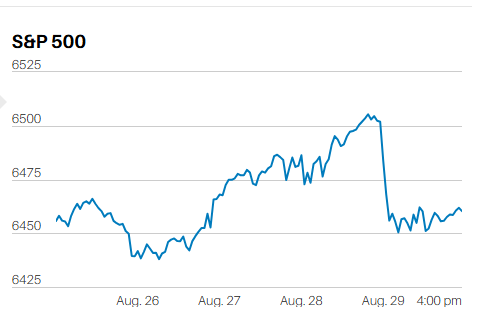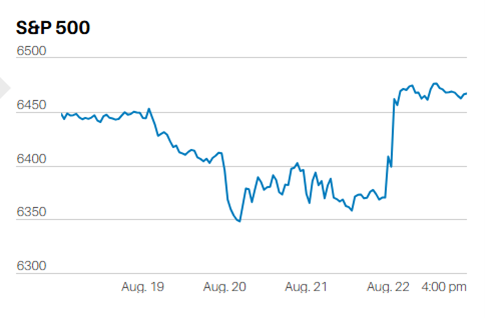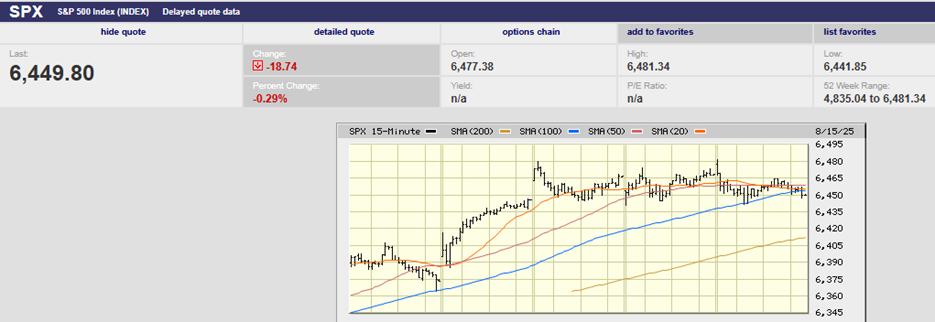Bond Prices continue to trend downward

Market Update
The S&P 500 rose 1.5% to 4500.53 last week. The index is up two weeks in a row after falling the first three weeks of the year. The S&P lost 12.4% during that three-week decline, after hitting a record high of 4818.62 on 4 January. The index bottomed at 4222.62 on 24 January after losing 596 points. The S&P closed 188 points above its low on the 24th, or about 4.4% higher. The index finished near its high for the day on the 24th. Every trader on the planet knows that the type of action on the 24th signals a short-term bottom at the very least. The next three trading days saw higher lows. The fourth trading day following the big reversal day saw a lower low that was bought by traders. It was off to the races after that as traders got confirmation of the short-term bottom. The S&P 500 rose 6.2% over the next four trading days starting on 28 January.
The point is that so far, the S&P 500 looks as if it is just bouncing from an oversold condition. The index took back the 200-day moving average during the bounce. It failed to take back the 50-day moving average. It also failed to hold the 20-day and 100-day moving averages Thursday and Friday, after closing above them earlier in the week. It did manage to remain above the 200-day on Friday, a small positive. The coming week is critical to the short-term direction of the S&P. It has completed a two-thirds retracement of the sell-off. The slow stochastic oscillator is signaling downside for the next few trading days. A retest of the 4222.62 low in the next couple of weeks is a real possibility. The S&P 500’s correction may not be over.
The Nasdaq’s correction has been deeper than the S&P’s. The Nasdaq is still down over 12% and is trading below its 200-day moving average. A retest of its 4 February low in the next week or two is likely.
Meanwhile, bonds are continuing to get pounded. Short and intermediate-term Treasury bonds are in a steep downtrend. Only long-term Treasuries haven’t fallen to new lows. The March 2021 low is approaching though. Bonds are heading for another losing year. The Vanguard Long-term Treasury ETF (VGLT) is down 5.97% YTD after losing 4.98% in 2021. The Vanguard Short-term Treasury ETF (VGSH) is down 1.01% YTD after losing 0.60% in 2021. Norwood Economics has been underweight bonds since 2020.
Economic Indicators
The Chicago PMI rose to 65.2 in January from 64.3 the prior month. Anything over 60 is considered very strong. The ISM manufacturing index was 57.6% in January down from 58.8% the prior month. It was the slowest pace for factory growth in 14 months. Still, anything over 50% indicates growth and 57.6% is still a strong number. The ISM services index was 59.9% in January down from 62.3%. It is still a strong number albeit the slowest growth in 11 months.
Job openings rose to 10.9 million from 10.8 million indicating a tight labor market. Job quits were 4.3 million in December down from 4.5 million in November. The job quits number again indicates a tight labor market.
Nonfarm payrolls rose 467,000 in January, well ahead of the 150,000 forecasted. The November and December numbers were revised higher by 709,000. The labor market is strong. The tight labor market is finally drawing people back into the workforce. The participation rate rose 0.3 to 62.2%, the highest since the pandemic began. Productivity jumped 6.6% in the fourth quarter, keeping the unit labor cost increase to 0.3%. Unit labor costs rose 9.3% in the prior quarter. Still, average hourly earnings rose 0.7% in January after rising 0.5% in December. Rising hourly earnings is a worrying sign for future inflation. Businesses will try to recoup some of the increases in wages by raising prices. The labor shortage will get worse as the service economy opens in 2022.
Interest Rate Hikes and What They Mean for Investors
An interest rate tightening cycle is expected to get underway in March. The Federal Reserve will have stopped buying bonds by then. No longer pumping $1.44 trillion into the system annually is tightening in its own right. The Fed Funds Futures market is pricing in a 0.25% rate hike at the March meeting. The probability of a 50-basis-point hike in March jumped to 36.6% on Friday, following the jobs report, according to the CME FedWatch site. Regardless of whether it is 0.25% or 0.5%, a hike is coming next month. Bank of America thinks the Fed will hike seven times in 2022, which is a lot of tightening. But BofA might be right because the Fed seems to know it is behind the curve.
Powell made it clear in his press conference following the Fed meeting that the Fed will be aggressive. He said inflation was “running substantially above 2% and more persistently” than they would like. He also said the labor market “by many measures” is at historic tights. And he pointed out that economic growth will be “substantially higher than what we estimate to be the potential growth rate” in 2022. Powell’s comments indicate the Fed will move aggressively in 2022 to raise rates. It will also start shrinking its balance sheet soon. Powell indicated that balance sheet shrinkage will move faster than last time. The Fed shrinking its balance sheet is also tightening.
The front-end of the yield curve will continue to rise as the Fed starts raising rates and shrinking its balance sheet. The market is pricing roughly 115 basis points (bps) of Fed funds hikes in 2022, according to Tim Ng of American Funds. Two-year yields are most influenced by the Federal Funds Futures rate. The two-year Treasury yields 1.35% as of Friday. It will rise throughout the rest of the year if the Fed follows through with tightening expectations. The ten-year Treasury will also rise, likely above 2.25% from its current 1.91%. Bond prices fall as yields rise. The 30-year Treasury yield may not rise. It may fall instead as the yield curve flattens. Four or five rate hikes may be enough to invert the yield curve by year-end. The yield curve inverts when 10-year Treasury yields are below three-month T-bills. Some economists use the 2-10 spread instead of the three-month T-bill/10-year spread.
An inverted yield curve signals impending recession. An inverted curve has preceded every recession in the last 50 years with only one false signal. There is a reason. Banks can’t borrow short and lend long when long-term rates are below short-term rates. Credit dries up and the economy slows, eventually falling into recession. It doesn’t happen immediately. It can take as long as two years.
Rising rates and a slowing economy are not good for the stock market either. Rising rates in 2022 should continue to pressure high-priced stocks. Norwood Economics is still expecting a flat domestic stock market in 2022 with value continuing to outperform growth. We will remain underweight bonds and overweight dividend-paying stocks.
Regards,
Christopher R Norwood, CFA
Chief Market Strategist











